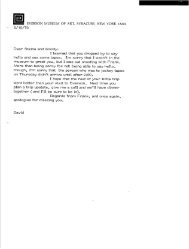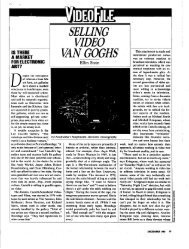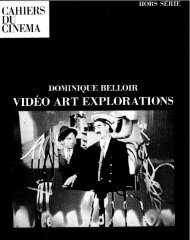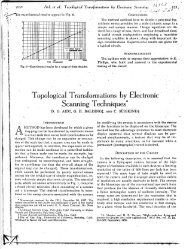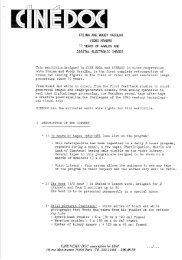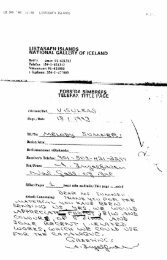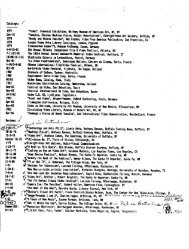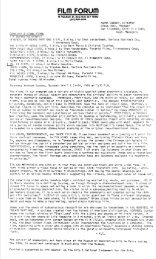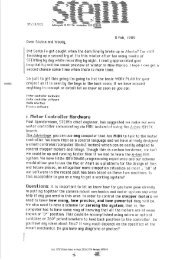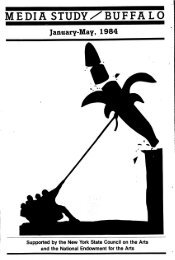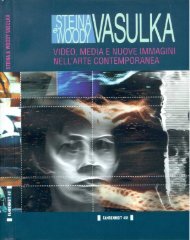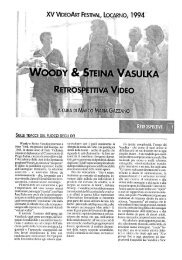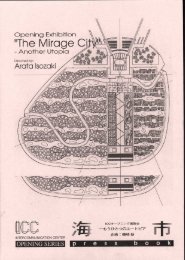Chapter 4: A HISTORY OF COMPUTER ANIMATION ... - Vasulka.org
Chapter 4: A HISTORY OF COMPUTER ANIMATION ... - Vasulka.org
Chapter 4: A HISTORY OF COMPUTER ANIMATION ... - Vasulka.org
You also want an ePaper? Increase the reach of your titles
YUMPU automatically turns print PDFs into web optimized ePapers that Google loves.
<strong>Chapter</strong> 4 : A <strong>HISTORY</strong> <strong>OF</strong> <strong>COMPUTER</strong> <strong>ANIMATION</strong> 3/20/92 38<br />
Stereoscopic animation, where a separate point of view is<br />
calculated for each eye, was first produced by A . Michael Noll at Bell<br />
Labs (1965) . Stereoscopic animation was not new, but when Noll<br />
animated the first four dimensional objects and mathematically<br />
projecting them from 4D to 3D stereo pairs, he provided a very<br />
unique way to actually look into the 4th dimension .<br />
The Bell work spanned a wide range of problems in addition to<br />
scientific visualization, typified in the first Zajak film, or language<br />
design, typified by Knowlton . Frank Sinden made the educational<br />
computer animation movie Force, Mass and Motion, which depicted<br />
the motion of bodies under various gravitational laws . It prooved<br />
conclusively that computer animation was a natural for science<br />
education .<br />
Thus by 1965 both vector and pixel computer animation<br />
techniques were defined . The simulation of image may be totally<br />
abstract and purely 2D, or it may derive from a pictorial<br />
representation . With pixels one may simulate all known analog<br />
effects (from fades to the traveling glow mattes of Luke<br />
Skywalker's light sword), plus some digital image effects that have<br />
no analog ancestry .<br />
The first color films<br />
Although color animation could be made by shooting black and<br />
white film and optically printing it with colored filters this was a<br />
tedious process . The solution was the development of continuous<br />
tone color film recorders . were built (independently) by General<br />
Electric in Syracuse and the Mathematical Applications Group (MAGI)<br />
in Elmsford, New York about 1966 . Both of these machines were<br />
raster only, and displayed the picture by interlacing each scan line,<br />
in other words, each scan-line was drawn successively in red, green<br />
and blue through rotating color filters before the next scan line was<br />
drawn . Software was progressing rapidly, and in 1968 GE produced a<br />
color computer animated film for NASA, 1984, that depicted the<br />
operations of a future space shuttle, perhaps the first movie that<br />
featured opaque colored solid objects and polygonal shading (fig . 68) .<br />
The following year their movies on Highway Interchanges and<br />
Hancock Airport included fog simulation ; flight simulation was a<br />
definite market area . Other experiments included architecture-<br />
68 . Solid, opaqued polygons, occulted surfacing (hidden surfaces<br />
removed), color, lightsourcing (Lambert, single color per polygon)<br />
and a moving camera mark the state of the art in 1966 systems by<br />
GE (left) and MAGI (right) .



